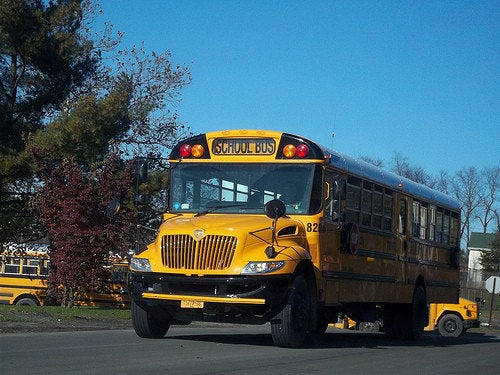
I love putting my four-year-old son Henry on the school bus. When he sees it coming, he jumps up and runs toward the door. I walk him out and turn him over to a matron, who helps him climb the stairs. Last year, she always put him in the last seat by the window, which made it easy for us to wave goodbye as she strapped him in. As the bus pulled away, he would beam at me through the window, so proud of himself and so delighted to be going to school.
Henry, who has Down syndrome, goes to preschool about three miles from our home in Manhattan. According to his Individualized Education Plan (IEP), the Board of Education is required to provide him with door-to-door transportation to and from school. Last year, it worked pretty well most of the time, although we grumbled about our surly driver and the annoying phone tree at the dispatch center.
But we're feeling positively nostalgic for those days as we confront the mayhem resulting from the New York State Board of Education's decision to cut costs on this year's bus contract for special education preschool students. Our saga began last Wednesday, when we got a call from our new provider, Consolidated Bus Transit, telling us that Henry would be picked up at 7 a.m. the next morning for his first day of school.
"Why so early?" I asked. "School doesn't start until 8:30 and we live only 10 minutes away. Last year's pickup time was 8:17."
I was told that Henry was the first stop on the route.
I said firmly that there was no way Henry could ride on the bus for an hour and a half.
The dispatcher was sympathetic but equally firm. For now, there was nothing to be done, but the route might be reconfigured over the next few days. She would call back with more information.
I thanked her, and told her we would take Henry to school until the problem was resolved.
For the next week, we schlepped Henry on the subway every morning. This meant that either my husband or I got to work late, but it saved him the grueling trip to school.
Meanwhile, the horror stories started to come in. On the first day of school, a friend's preschool age son (also disabled) had no bus at all. Another day he was picked up at 7:40 a.m., although his school doesn't open until 9:30 a.m. He arrived home (a 20-minute drive from school) at 4 p.m., after riding the bus for an hour and a half. The Daily News ran a story about a boy who was picked up at 10 a.m. for a school day that started at 8:30 a.m. A second story reported on a traumatic five-hour bus ride home for a preschooler with autism.
Parents are rightly incensed about the impact of this confusion on their children, some of whom have disabilities that make a chaotic bus not just irritating but unsafe. It's also an opportunity to remember that the education of children with disabilities is a right parents and advocates fought long and hard to achieve, one that is constantly endangered by the cost-cutting measures of politicians and bureaucrats. Until the passage of the 1975 Education for All Handicapped Children Act, the prospects for educating children with disabilities were bleak. Many states had laws that barred children with disabilities such as deafness, blindness, emotional disturbance and other cognitive delays from public education. According to a research study completed in 1970, only 1 in 5 children with disabilities had received an education in school. Thanks to the Individuals with Disabilities Education Act of 1990 all children are entitled by law to a "free appropriate public education." Safe and reliable bus service is an essential part of that education.
Let's also remember the symbolic importance of buses in American struggles for justice. Buses occupy a central place in the civil rights movement, which was sparked by Rosa Parks' refusal to give up her seat to a white passenger. Following the landmark Brown v. Board of Education decision, school buses became symbols of desegregation as they transported minority children into higher-income white neighborhoods. As students with disabilities entered public school in increasing numbers, school buses were equipped with wheelchair lifts and new standards for dealing with medically fragile children. Today, buses should serve as a symbol of inclusive education but instead they are often a sign of the incompetence and neglect of state bureaucracies.
Yesterday morning things were better with our bus. A dispatcher called at 8 a.m. to say a bus would be downstairs in five minutes. The bus that arrived ten minutes later was clean and well maintained. Both the matron and driver were friendly and helpful. After seeing Henry off, my husband went back upstairs to get his briefcase. Coming into the apartment, he heard a dispatcher on our answering machine, saying the bus would be downstairs in five minutes. With a sense of déjà vu, he went back downstairs. When the second bus arrived -- also clean and well maintained, with a friendly driver and matron -- he explained that our son had left on an earlier bus. As they drove away, we had to wonder whether the fact that we got two buses meant that some other child had received no bus service at all that day. Of course, two buses is better than none, but we're a long way from the day when every preschooler in New York gets the service he or she is entitled to.